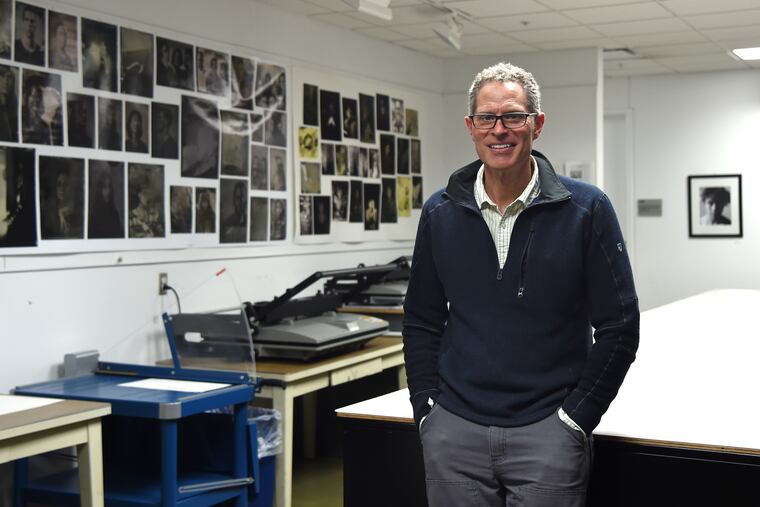A sock and a snapshot: How a Temple professor helped state police crack a cold-case murder
Byron Wolfe sharpened a 28-year-old photo that proved crucial to the arrest of Theodore Dill Donahue.

In 2015, Byron Wolfe helped a Pennsylvania State Police detective enhance 24-year-old photographs. The work took two hours, and Wolfe promptly forgot about the case, chalking it up as a simple favor, he recalled recently in his office on Temple University’s campus.
Last month, he was reading an article in The Inquirer about a major break in a cold-case murder that had dogged investigators for decades. The headline grabbed his attention. As he read, the details deepened his interest. And then it all came together.
On Sept. 3, almost four years to the day of Wolfe’s fateful meeting with Trooper Andrew Martin, Theodore Dill Donahue was arrested in the 1991 slaying of Denise Sharon Kulb, his ex-girlfriend. And investigators have since said an important step in bringing those charges forward was enhancements Wolfe made to those photographs, which, unbeknownst to him at the time, were gruesome mementos recently recovered by detectives.
“I was really just shocked to see the news,” said Wolfe, the head of the photography program at Temple’s Tyler School of Art and Architecture. “Some of it was just surprise. But I was satisfied, gratified that I was able to do something to help.”
Martin, a member of the state police Criminal Investigation Assessment unit, touted Wolfe’s assistance as an example of the collaborative approach his team takes to resolving persistent cold cases.
“It bodes well to show that these cases can be community efforts, and that when everyone gets behind them, it gets results,” Martin said.
Donahue’s lawyer, R. Emmett Madden, told The Inquirer in September that his client is innocent and plans to dispute the charges.
Martin had dusted off Kulb’s case file not long after joining the unit in 2014. To him, it seemed as if there were still more to be done with the investigation, efforts not taken or limited by the tools available at the time.
Part of his renewed effort involved focusing not just on victimology, but on the man detectives had eyed as the prime suspect in 1991. Martin and his colleagues approached friends of Donahue, people who were close to him at the time of Kulb’s death.
Not long before, they told him, Donahue, now 52, had begun to discuss Kulb’s death with them, providing information that contradicted statements he had made to police 28 years ago. Through these conversations, Martin and his team recovered keepsakes Donahue had saved from that period.
Among them was a snapshot that appeared to depict Kulb, according to Martin. The small, darkly lit print had a timestamp from the same month Kulb’s body was found in Chadds Ford Township, Delaware County.
But the quality of the photo was poor. Martin knew he’d need some outside help in improving it.
He took that photo and a few others from the time of Kulb’s death to Wolfe. As an academic, Wolfe had some experience with using photos to decipher the past — a previous project for a colleague saw him working backward to determine Billy the Kid’s height using an old tintype of the legendary outlaw holding a rifle.
Helping to catch a killer? That was a new challenge.
“Whether you’re a photographer or a detective, one’s individual sense of awareness of what to pay attention to or what’s important is probably more important than the technology itself,” Wolfe said. “In 1991, those photographs existed, and this is not a critique on the investigators, but no one had that awareness to slow down to look at them.”
Through color correction and other editing techniques, Wolfe enhanced the photographs for Martin. His work uncovered previously unseen details, including that a sock found next to Kulb’s body matched one detectives pulled from Donahue’s apartment during a search in 1991.
After four more years of police work, a case that had been dormant for years suddenly accelerated. But Wolfe said the credit for that lies chiefly with Martin and his team.
“The detectives are the ones who went back and looked at the information,” Wolfe said. “They’re the ones who had the initiative to reexamine the photographs and said, ‘Can we get something else out of these?' ”
Philadelphia District Attorney Larry Krasner, whose office is prosecuting Donahue, praised the measures taken by the state police, including their idea to bring in Wolfe.
“The truth is, at any given time, we’re looking at several cold cases,” Krasner said. “Fundamentally, it derives from the fact that we think we have a duty to do justice moving forward, but also to look backward, and sometimes that means rearresting somebody or testing DNA.”
Martin, for his part, agreed.
“It was just a matter of being methodical and taking the time," he said. "And once we had built up that momentum, we were able to see them through.”